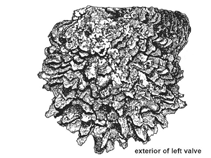Pinctada maxima (Jameson, 1901)
Silverlip pearl oyster| Native range | All suitable habitat | Point map | Year 2050 |

|
| This map was computer-generated and has not yet been reviewed. |
| Pinctada maxima AquaMaps Data sources: GBIF OBIS |
Classification / Names Common names | Synonyms | CoL | ITIS | WoRMS
Gastropoda | Ostreida | Margaritidae
Environment: milieu / climate zone / depth range / distribution range Ecology
Benthic; depth range 0 - 60 m (Ref. 348), usually 5 - 30 m (Ref. 348). Tropical
Distribution Countries | FAO areas | Ecosystems | Occurrences | Introductions
Indo-West Pacific: from Nicobar and Andaman Islands to Melanesia; north to Japan and south to Queensland and Western Australia; Borneo and Moluccas.
Length at first maturity / Size / Weight / Age
Maturity: Lm ? range ? - ? cm Max length : 30.0 cm ShL male/unsexed; (Ref. 348); common length : 20.0 cm SHH male/unsexed; (Ref. 348)
Short description Morphology
Shell rather thick and large (attaining 30 cm in length), subcircular in outline, with a short and ill-defined posterior ear which is not drawn out into a wing-like process. Anterior margin markedly protruding beyond the tip of anterior ear. Outer surface of valves, when not worn, covered with flattened, imbricating concentric scales bearing large and irregular, flat spines with blunt ends, roughly arranged in radial rows and projecting at shell margins. Hinge completely devoid of teeth. Colour: outside of shell uniformly fawn, sometimes with radial stripes of darker spots in umbonal region; then, ground colour in that region green, dark brown, or purple. Internal nacreous area highly lustrous, silvery with a variably extended golden border. Non-nacreous margin clear, of plain horny colour.
Mainly in clear water under the influence of currents. Often in dense colonies. Littoral and sublittoral to a depth of 60 m; most common from sublittoral at depths of 5 to 30 m (Ref. 348). On various bottoms, byssally attached to hard substrates at least in the young stages (Ref. 348). Inhabits a broad range of habitat, from sand, mud, gravel, seagrass beds, deep-water reefs, to near sponges, soft corals or whip corals. Filter-feeder (Ref. 101206).
Life cycle and mating behavior Maturity | Reproduction | Spawning | Eggs | Fecundity | Larvae
Members of the class Bivalvia are mostly gonochoric, some are protandric hermaphrodites. Life cycle: Embryos develop into free-swimming trocophore larvae, succeeded by the bivalve veliger, resembling a miniature clam.
Main reference
References | Coordinator | Collaborators
SAUP Database. 2006. (Ref. 356)
IUCN Red List Status
(Ref. 130435: Version 2024-2)
CITES status (Ref. 108899)
Not Evaluated
CMS (Ref. 116361)
Not Evaluated
Threat to humans
Human uses
Fisheries: commercial
| FishSource | Sea Around Us
Tools
More information
Trophic Ecology
Ecology
Population dynamics
Growth
Max. ages / sizes
Length-weight rel.
Length-length rel.
Length-frequencies
Mass conversion
Recruitment
Abundance
Max. ages / sizes
Length-weight rel.
Length-length rel.
Length-frequencies
Mass conversion
Recruitment
Abundance
Life cycle
Human Related
Aquaculture profiles
Stamps, coins, misc.
Stamps, coins, misc.
Outreach
References
Internet sources
BHL | BOLD Systems | CISTI | DiscoverLife | FAO(Publication : search) | Fishipedia | GenBank (genome, nucleotide) | GloBI | Gomexsi | Google Books | Google Scholar | Google | PubMed | Tree of Life | Wikipedia (Go, Search) | Zoological Record
Estimates based on models
Preferred temperature
(Ref. 115969): 24.4 - 29.1, mean 28.2 (based on 1342 cells).
Resilience
(Ref. 69278):
High, minimum population doubling time less than 15 months (K=0.72-0.79).
Price category
(Ref. 80766):
Unknown.
Nutrients : Calcium = 149 [71, 228] mg/100g; Iron = 8.53 [1.95, 15.11] mg/100g; Protein = 9.88 [8.64, 11.12] %; Omega3 = 0.313 [0.202, 0.423] g/100g; Selenium = 61 [50, 72] μg/100g; VitaminA = 0 μg/100g; Zinc = 2.04 [0.56, 3.51] mg/100g (wet weight); based on nutrient studies.



